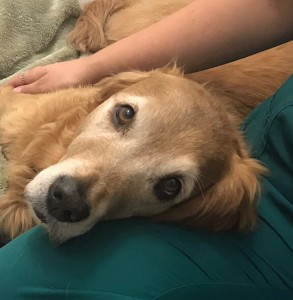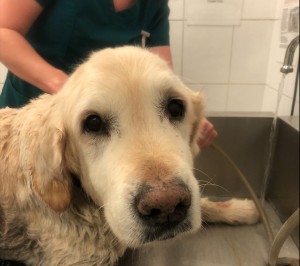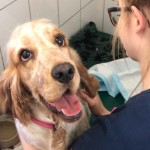News
Archive for the ‘Pet of the Month’ Category
Pet of the month – December – Barry
by admin on December 3rd, 2018
Category: Pet of the Month, Tags:
We are delighted to report that he has responded well to treatment but unfortunately we have been unable to locate Barry’s owner. Fingers crossed!
Pet of the month – November – Kim
by admin on November 1st, 2018
Category: Pet of the Month, Tags:
Pet of the month for November is Kim, a 14 year old Golden Retriever, seen here having her weekly bath. Kim has suffered from an underactive thyroid for some years and despite longterm supplementation with thyroid hormone still suffers from a flaky skin, which is a common symptom. Other than that the condition is being well managed.
What is hypothyroidism?
Hypothyroidism develops when the thyroid gland function falls below normal. In dogs and cats the two thyroid gland lobes lie on either side of the windpipe and produce thyroid hormone. This hormone controls the speed at which the body’s metabolism works. In patients with hypothyroidism, not enough of the hormone is produced. As a result the metabolism ‘slows down’, and, with time, this can affect almost all the organs of the body.
Hypothyroidism is common in adult dogs, but is very rare in cats.
How do animals get hypothyroidism?
In the majority of cases hypothyroidism is diagnosed in adult dogs that have previously been healthy. In most dogs the disease either develops due to the affected animal’s own immune system attacking the thyroid gland (‘lymphocytic thyroiditis’) or due to degeneration of the gland tissue. It is possible that both forms of the condition may in fact represent the same disease process. Over time, more and more thyroid tissue is destroyed until the gland cannot function any longer.
It is still not known why dogs develop this disease. Certain breeds of dogs are more susceptible to hypothyroidism – these include Retriever breeds, Doberman Pinscher, Setters, Terrier breeds and Spaniels (especially Cocker Spaniels). Hypothyroidism is rare in toy and miniature breeds. Several factors have been proposed that could trigger the immune reaction, but so far nothing has been proven.
Hypothyroidism is extremely rare in cats, but can very occasionally be seen after zealous treatment of an overactive thyroid gland.
In rare cases puppies and kittens are born without a functioning thyroid gland.
What are the clinical signs of hypothyroidism?
As the disease affects the whole metabolism, clinical signs are often vague and non-specific and can affect almost every aspect of the dog’s body. The disease can also mimic many other problems.
Many dogs are presented with weight gain and lethargy or lack of interest in activities they previously enjoyed. However, the majority of dogs presented because of weight gain are simply overweight because they eat too much (See Nutrition advice for dogs information sheet).
Often a ‘tragic expression’ of the face is noticed by owners of dogs with hypothyroidism, and this is due to thickening of the skin and loss of tone of facial muscles. A dull coat, greasy or darkened skin and hair loss, especially on the sides of the body and the tail, are also frequently noticed. Constipation can develop, although diarrhoea is also a possible problem because the immune system is less effective. This reduction in immunity can also lead to other infections such as chronic skin or ear problems. Less commonly, more severe clinical signs can be seen, such as those related to nerve function problems.
Hypothyroidism is not usually fatal, but it can compromise an affected dog’s quality of life.
Puppies and kittens born without a functioning thyroid gland do not grow properly and their mental development may be affected. Many of these patients do not survive, and those which do often suffer from chronic arthritis because of abnormal joint development.
Adult cats with hypothyroidism show similar signs to dogs, but such cases have only very rarely been reported.
How is the disease diagnosed?
Hypothyroidism is diagnosed by blood testing – the amount of thyroid hormone in the blood as well as the amount of TSH (a hormone that controls the function of the thyroid gland) is measured. However, further blood values are also looked at in order to test for other diseases, because the clinical signs of thyroid disease are not usually very specific. Depending on the individual case it may also be necessary to analyse a urine sample or even to perform further tests such as radiography (X-rays) or ultrasound examination.
If other diseases can be ruled out and the blood values show low thyroid hormone, then a diagnosis of hypothyroidism can be straightforward. However, not all blood tests results lead to a clear-cut diagnosis as thyroid hormone measurement can be influenced by a variety of other factors. In such cases it may be necessary to perform further blood tests, or in some cases to re-test after several weeks or months to confirm the disease. In some cases the diagnosis of hypothyroidism can be quite problematic.
Can hypothyroidism be treated?
Once hypothyroidism has been diagnosed, it can be readily treated with tablets containing thyroid hormone. The condition can be controlled rather than cured, and life-long medication has to be given to provide the body with thyroid hormone. As the required dose can change over time, repeat blood tests are necessary at intervals to check the level of hormone in the blood.
The clinical signs of hypothyroidism will improve with treatment but it can take several months for all the signs to resolve.
My pet has hypothyroidism, what is the outlook?
Once a pet is stabilised on medication, it will not be noticeable to anyone – including the animal – that he or she actually has a chronic disease. Pets with hypothyroidism that are on therapy have an excellent prognosis and can expect to live a normal life, as long as they receive medication and are properly managed with the help of your veterinary surgeon.
Pet of the month – October – Niamh
by admin on October 1st, 2018
Category: Pet of the Month, Tags:
Blood tests showed Niamh to have developed renal failure and because of the unique and unusual nature of the presentation she was referred to a specialist. Further diagnostic work indicated ‘acute on chronic’ kidney disease – very unusual in a five year old dog, as she was then.
Niamh has been the sweetest of patients with an extremely friendly, upbeat nature even when has been feeling very ill; despite the gravity of her illness she made great progress and was in remission until earlier this year when she started to deteriorate again. With appropriate treatment Niamh’s blood results have improved and we are hoping she may be back in remission again very soon.
Pet of the month – September – Mawgan
by admin on August 31st, 2018
Category: Pet of the Month, Tags:
Pet of the Month for September is a delightful Golden Retriever called Mawgan, seen here recovering from surgery in the lap of one of our nurses.
He came in to the clinic for our August Offer which was designated Check-a-Lump Month and subsequently underwent surgery to remove 2 lumps from his feet.
We are pleased to report that Mawgan is recovering very well!

Pet of the month – August – Max
by admin on August 1st, 2018
Category: Pet of the Month, Tags:
Max is recovering from a severe anaemia caused by a flea infestation. The severity was in fact so great that Max had to have an emergency blood transfusion, and his coat was completely shaved off.
Fleas are a blood sucking parasite and in sufficient numbers can deplete the number of red blood cells circulating in the body. The very prolonged warm spell we are having is causing flea numbers to rise exponentially. Each flea can lay up to 50 eggs daily and these can hatch within 14 days in hot weather. Although it is extremely unusual for a pet to be parasitised by fleas to this extent it is a warning to us all to maintain flea and all anti-parasite control this summer.
Pet of the month – July – Elsa
by Hannah Wright on July 9th, 2018
Category: Pet of the Month, Tags:
We are so pleased to report that delightful Elsa is making good progress after a very severe bout of Haemorrhagic Gastroenteritis (HGE).
Elsa’s symptoms were initially intractable vomiting. As she did not respond to therapy and has a habit of eating wood which can be very hard to detect on imaging, she underwent an exploratory operation to check that she had not swallowed any. This might in turn have splintered, perforated the bowels and caused peritonitis. Thankfully this did not prove to be the case, however did develop haemorrhagic diarrhoea. Appropriate and swift therapy has put her on the road to recovery!
Pet of the month – June – Bertie
by admin on June 1st, 2018
Category: Pet of the Month, Tags:
What possessed Bertie, at 19 years of age, to change the habits of a lifetime and consume some glass nobody will ever know, but luckily his owner was at hand and observed this.
She quickly rushed him in to the surgery, where radiographs confirmed the presence of 3 pieces of glass in his stomach. Despite worries over his age Bertie underwent an exploratory laparotomy under general anaesthesia to locate and remove the glass.
We are delighted to report that Bertie is doing really well and has bounced back to health!
Pet of the month – May – Pepper
by admin on May 1st, 2018
Category: Pet of the Month, Tags:
Pepper is Pet of the Month for May. She is a rescue dog with a chequered past who has recently found a good home. Her new owner is making good progress dealing with her separation anxiety.
Separation anxiety and behavioural problems can occur in dogs when they are left home alone.
Dogs are social creatures that have evolved to live with humans. It isn’t surprising therefore that unwanted behaviour sometimes occurs when a dog or puppy is left ‘home alone’. However, whilst it is often assumed that the problem behaviour is triggered by ‘separation anxiety’, this is not always the case. It is therefore very important that the reason for the unwanted behaviour is clearly identified for each individual.
What sort of problem behaviour is typically seen?
The most commonly reported separation problems in dogs are excessive barking or howling, eliminating indoors and damage to the house or its contents. Dogs may also show physical symptoms such as excessive salivation, or compulsive behaviours such as pacing or excessively licking themselves. Most start to show the problem behaviour as soon as the owner has left, but others may not do so for some time or may start to feel distressed as soon as they realise the owner is about to go out. They may then try to stop them leaving, perhaps by blocking their access to the door or – rarely – by becoming aggressive.
What causes separation anxiety or other problem behaviour when a dog is left alone?
Dogs may show unwanted behaviour when alone for a wide variety of reasons. For example elimination may be an involuntary reflex reaction due to separation anxiety. However, it may also occur because the dog isn’t properly house trained and so eliminates if he is caught short whilst the owner is out. It may be due to a urinary tract infection or another medical problem that makes the dog need to eliminate more often. In geriatric dogs it may be due to declining mental faculties resulting in confusion about when or where to eliminate.
Separation anxiety and other problem behaviour when a dog is home alone may occur for a wide variety of reasons
Destructive behaviour when left alone, such as when the dog scrabbles at a door or window, may be caused by the dog trying to follow the owner due to separation anxiety. Alternatively, the dog may chew out of boredom or may cause damage whilst trying to get to something he wants. It also isn’t uncommon for a dog to spend a happy afternoon raiding the cupboards and fridge when left alone in the kitchen, but to settle perfectly happily if left in a room where there is no access to food. This is more a case of ‘whilst the cat’s away….’ than emotional distress.
Vocalisation may also have multiple causes. Dogs vocalise to communicate and may howl or bark for prolonged periods due to separation anxiety. However, they are also likely to bark if someone approaches the property and they are trying to guard it. It therefore can’t always be assumed any barking or howling is triggered by emotional distress at being alone.
Even where the unwanted behaviour is triggered by emotional distress, this may arise for different reasons in different dogs. Some dogs appear to become overly attached to or dependant on their owner. These dogs seem genuinely distressed at being separated from them. In other cases the distress may be because the dog didn’t learn to feel comfortable being alone as a puppy. He may then become distressed the first time this happens, such as when a family member returns to work or a doggy (or feline) companion dies. Some may bark and scrabble at doors out of frustration because they want to accompany the owner on their adventure into the wide world outside. In a few cases the unwanted behaviour is triggered by something happening when the owner is out that makes the dog scared. This can then lead to the dog becoming fearful whenever they are alone in case it happens again.
How do we know what is causing the separation anxiety or other problem behaviour?
Finding the causes for separation anxiety (or other problem behaviour) requires a careful assessment of what is happening when the dog is both with people and alone. Video recordings of the dog’s behaviour when no-one is there can also be very revealing.
For example if a dog causes damage to doorways as soon as and every time the owner leaves, this is likely to be due to some kind of emotional distress. Observation of the behaviour will show if it is due to anxiety or frustration, and the dog’s history will reveal if it’s due to lack of familiarisation as a puppy or over attachment. If the behaviour doesn’t occur until much later, is directed to household contents and occurs in a young or under exercised dog, it is more likely to be boredom. If the behaviour is intermittent, video recordings may reveal certain triggers for the behaviour, such as when bins are collected in a dog with a phobia of lorries.
How can we prevent separation anxiety and other separation problems in dogs?
Most puppies can be familiarised to being home alone if they are taught to gradually accept this when they are very young. Other problem behaviours can be prevented by teaching your dog to prefer being outside when he wants to eliminate and making sure he has plenty of exercise, stimulation and companionship.
Top tips to help familiarise puppies to being home alone
- Start by leaving when your puppy is tired, well fed and has just been out into the garden
- Place your puppy in a safe area such as his crate or a puppy proofed area of the house
- Give your puppy something engaging e.g. a new toy, or a food item such as a Kong with a small amount of food inside
- Leave calmly but don’t sneak away – it is important that your puppy knows you have gone
- Initially leave for just five minutes. Make sure you are somewhere your puppy cannot hear, see or smell you
- Come back after the allotted time regardless of what is happening e.g. barking or whining
- If your puppy is quiet he can be greeted immediately
- If he is making noise ask him to ‘sit’, then give attention when he obeys. If he doesn’t yet know this command just wait for him to be quiet then greet him. Don’t ignore him for long periods as this is punishing
- Repeat 3-4 times a day. He should quickly stop being concerned by you leaving and settle to his toy or food item
- You can then start to increase how long he is left for. Start by increasing this by five minutes at a time, up to 30 minutes, then by 10 minutes at a time up to an hour. Each increment should be repeated 3 or 4 times. As the duration he is left for goes up the frequency can reduce
- Even puppies that live with another dog must learn to be alone
How can we stop this behaviour?
If prevention hasn’t worked then the method of correction will depend on the cause. For example, if indoor elimination is due to a lack of house training this can be rectified by teaching the dog to prefer to be outside to eliminate using similar methods to those used with puppies. If the dog is being destructive due to boredom this may be helped with toys, improvements in overall exercise and stimulation or reducing the period of time the dog is left alone. However more complex problems may require a tailored treatment package developed specifically for your dog’s needs by a specialist in this area. If your pet is showing problem behaviour when left alone then discuss this with your vet. They will be able to rule out any underlying medical problems and, if necessary, refer you to a suitably qualified behaviour expert.
Pet of the month – April – Hank
by admin on April 3rd, 2018
Category: Pet of the Month, Tags:
In his owners words:
“Hank, my 7 year old black Labrador had been competing in a working test on Sunday and wasn’t his usual self. He seemed reluctant to jump and just wasn’t as obedient as he normally is. I have no idea if he was already feeling a little off colour that day, and guess I will never know. Within 45 minutes of eating his dinner that evening he started to try and vomit, but nothing was coming up. He was stretching, lying in the praying position and just generally not looking very happy. I was immediately suspicious that this could be a torsion and so I rang Lisa and Kate who agreed to see him. By the time I got to the surgery at 6.30 pm he was clearly becoming distressed, so we x-rayed his abdomen and it was showing that indeed he had a twisted stomach. By then was pale and shocked and his abdomen was getting larger by the minute. Hank was put on fluids and prepped for surgery. His surgery lasted over 3 hours, but was thankfully successful.
Only 48 hours after surgery, Hank was allowed home, and has made an amazing recovery. He is now training once again and exercising normally. I guess after all the years working at Fitzalan House I have learnt a thing or two as I managed to spot the signs of what was happening but without the prompt veterinary care he received I could have easily lost him. I am so very grateful for Lisa and Kate’s attention to him that night, they undoubtedly saved his life, and I cant thank them enough.”
What is gastric-dilatation and volvulus (GDV)? Is my dog at risk? Gastric dilatation and volvulus, or GDV as it is commonly abbreviated, is a relatively common clinical syndrome seen in large / giant breeds of dog. Dilatation refers to bloating of the stomach with gas, and volvulus refers to twisting of the stomach about its axis. The cause of this syndrome is not completely understood. In fact it is quite controversial which occurs first; the bloat or the volvulus (twisting). Indeed both components do not have to occur together and some patients will develop relatively simple bloat alone. GDV is a potentially life threatening condition and emergency veterinary attention should be sought immediately if it is suspected.
Why is GDV potentially life-threatening to dogs?
There are a number of serious and potentially fatal consequences that occur as a result of GDV. Initially the severe distension of the stomach stretches the blood vessels over its surface reducing the blood supply to the stomach walls. This is made worse by the twisting of the stomach which also twists the blood vessels, effectively shutting off blood supply to the stomach. A lack of blood flow means there is a lack of oxygen and nutrients delivered to the stomach and waste products are not removed. As with any organ this will result in parts of it dying. This process happens very quickly and in severe cases could result in part of the stomach wall rupturing and releasing its contents into the abdomen.
The large distended stomach occupies much more space inside the abdominal cavity and compresses surrounding structures. Severe distension puts pressure on the diaphragm and interferes with the patient’s ability to breath. It also applies pressure to a large blood vessel in the abdomen (the vena cava) that normally returns blood from the back half of the body to the heart. Pressure on this vessel obstructs flow therefore reducing the amount of blood returned. If blood can’t be returned to the heart, then it in turn can’t pump it out to the rest of the body. If there is insufficient blood being pumped, the blood pressure falls dramatically making the patient weak and potentially leading to collapse.
To add insult to injury, other organs in the body such as the lungs, kidneys, liver and intestines do not receive a blood supply and begin to fail. The lack of a functional circulation also means that toxic products build up in these organs that further compromise the patient. These changes can happen in a matter of hours, emphasizing the importance of early veterinary attention.
What are the symptoms of GDV in dogs?
The symptoms generally include obvious distension or enlargement of the abdomen with unproductive vomiting or retching. The patient may drool excessively and appear restless or agitated. As the condition progresses the patient may become increasingly weak or even develop shock and collapse.
What is the treatment for GDV?
The age and breed of the patient coupled with the clinical signs of a severely bloated abdomen will make your vet highly suspicious of this condition. They will immediately place one or more an intra-venous catheters to allow administration of fluids to support the circulation and dilute toxins in the blood. They may also analyse the patient’s blood to assess the severity of organ damage.
The next stage involves attempts to decompress the stomach. This is usually accomplished by passage of a specially designed tube through the mouth down into the stomach. There is a gag that can be used to assist in this process but many patients will require sedation or anaesthesia to complete the task. It can be very challenging or sometimes impossible to perform stomach tubing. This is particularly the case when the stomach is twisted 360 degrees or more. In this instance a cannula (tube) may have to be inserted through the body wall and into the stomach to allow deflation. Deflation is clearly an imperative step because it will relieve pressure on the diaphragm and help restore blood flow back to the heart through the vena cava.
Radiographs of the abdomen are often required to help distinguish between simple dilatation and dilatation with volvulus. In the latter case surgery will be required as soon as the patient is stabilised. The aim of the surgery is to de-rotate the stomach and assess it for areas of devitalisation. If there are areas of the stomach that have undergone necrosis (died), these need to be removed surgically.
It is vital that the stomach is attached to the inside of the body wall. This is called a gastropexy and it will prevent volvulus in the future. This is essential as up to three quarters of the patients that do not have this performed will have another episode in the future. This also applies to those patients suffering with bloat alone as they have the same risk.
What are the risk factors for GDV in dogs?
There are several factors that have been clearly demonstrated to increase an individual’s risk of developing this condition. These include:
- Being a purebred large / giant breed
- Having a deep and narrow chest conformation
- Having a history of previous bloat
- Having a history of bloat or GDV in a first degree relative (parent or sibling)
- Increasing age
- Having an aggressive or fearful temperament
- Eating fewer meals per day
- Eating rapidly
- Being fed a food with small particle size
- Exercising or stress after a meal
What breeds are predisposed to this condition?
The breeds most commonly affected are large purebred dogs that have a narrow deep chest confirmation. Those at most risk include:
- Great Danes
- Gordon setters
- Irish setters
- Weimaraners
- St. Bernard’s
- Standard poodles
- Bassett hounds
Although these are the breeds we typically see GDV in, it is worthy to remember that it can happen in any patient.
What is the prognosis?
With improved understanding of the secondary consequences of GDV and excellent anaesthesia, surgical and post-operative care now available for veterinary patients a good prognosis can be achieved for this condition. Survival rates of 73-90% would be typical. There will always be a range quoted for survival because individual patient’s circumstances in terms of severity, age, general health and treatment received will have an impact on the outcome. One important factor that has been shown to decrease the survival is the presence of clinical signs for greater than six hours. This emphasizes the importance of prompt veterinary attention in all cases.
If you are in any doubt that your dog is suffering from bloat or GDV, please call your vet immediately.
Pet of the month – March – Poppy
by admin on March 1st, 2018
Category: Pet of the Month, Tags:
 Meet our wonderful slimmer, Poppy. She started Sienna’s weight clinic at a whopping 17kg and now weighs 12.7kg. Her overall weight loss is absolutely enormous! Poppy and her owners have done so well to achieve her target weight!
Meet our wonderful slimmer, Poppy. She started Sienna’s weight clinic at a whopping 17kg and now weighs 12.7kg. Her overall weight loss is absolutely enormous! Poppy and her owners have done so well to achieve her target weight!
Her quality of life has improved dramatically. She attends hydrotherapy once a week for her hip problems and now swims with jets on because she’s too good!
Congratulations Poppy!!
Canine obesity is in fact the most common nutritional disorder seen in dogs. As with humans, it’s caused by an imbalance of taking in more energy than giving out. This can give rise to a persistent and potentially life threatening energy surplus.
How to know if your dog is overweight
Signs of canine obesity include owners struggling to see or feel their dog’s ribs, spine or waistline; abdominal sagging; a bigger, rounder face; a reluctance to go for walks or lagging behind; excessive panting; and the dog appearing tired and lazy. Grossly overweight dogs may even need assistance getting up and down, in and out of vehicles, and often refuse to move or play games.
Problems associated with obesity
Vets see these problems all too often, with obese pets posing greater risks from anaesthetic and surgical complications, heat or exercise intolerance, complications from cardio-respiratory disorders, hormone problems, skin disease, cancer, urogenital disorders, even early death. Canine obesity may even contribute to tracheal collapse and laryngeal paralysis too.
Common canine problems suffered as a result of obesity include diabetes (where the pancreas fails to secrete enough insulin in order to regulate blood glucose levels); heart disease (caused by high cholesterol levels); as well as arthritis directly affecting mobility, making it even harder for your pet to lose weight.
Until fairly recently, fatty tissue was thought to be just a relatively lifeless energy store and insulator; but we now know it secretes hormones affecting appetite, inflammation, insulin sensitivity and bodily function, as well as influencing water balance and blood pressure leading to kidney disease and high blood pressure.
Ways to prevent obesity
If your dog is overweight then carefully start changing his feeding habits; increasing exercise (e.g. more or longer walks, or take up a canine activity such as agility or flyball); looking at the type of food and his intake; creating a feeding plan.
One of the very best ways is to make regular visits to your vet nurse for weight loss advice and to have free weight checks and record your success.
Come and join our weight clinics today! There is a small £5 joining fee after which you and your pet receive a weight management booklet with tips on keeping your pet at a healthy weight, body condition score chart, measuring cup, calorie chart of common treats, food diary and leaflets on foods available to help your pet lose weight.
This is followed by regular free of charge check-up appointments to ensure your pet reaches his/her optimal weight.
Phone today to book an appointment with our weight management nurse Sienna!









